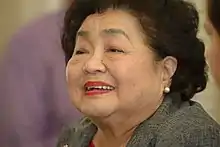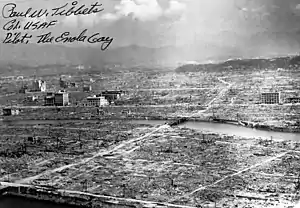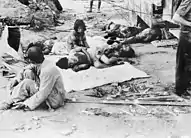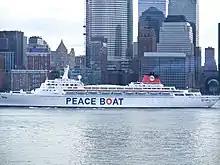Setsuko Thurlow
Setsuko Thurlow (サーロー 節子, Sārō Setsuko, born 3 January 1932), born Setsuko Nakamura (中村 節子, Nakamura Setsuko), is a Japanese–Canadian nuclear disarmament campaigner and Hibakusha who survived the atomic bombing of Hiroshima on 6 August 1945. She is mostly known throughout the world for being a leading figure of the International Campaign to Abolish Nuclear weapons (ICAN) and to have given the acceptance speech for its reception of the 2017 Nobel peace prize.
Setsuko Thurlow | |
|---|---|
 Setsuko Thurlow on 27 October 2017 | |
| Born | 中村 節子 Nakamura Setsuko 3 January 1932 Hiroshima, Japan |
| Nationality | Japanese, Canadian |
| Known for | Anti-nuclear activism, Peace activism, Social work |
| Awards | Nobel peace prize ICAN, Officer of the Order of Canada, Queen Elizabeth II Jubilee award, Nuclear Age Peace Foundation’s Distinguished Peace Leadership Award, Ahmadiyya Muslim Peace Prize |
Earlier life
Setsuko Thurlow was born in Hiroshima Kojin-machi (today suburb of Minami) in 1932 and is the youngest of 7 children.[1] She comes from a comfortable background. Her brothers and sisters being older and therefore having left the family home, she was the last one to live with her parents.[2]
In 1944, she entered in the girls only Hiroshima Jogakuin high school. Three weeks before the bomb, she was selected to participate in a student state program to decode American military communications as an assistant.[3][4]
Experience of the nuclear atomic bomb
On Monday August 6, 1945, she was working as a member of the student mobilisation program in the army headquarters (Higashi suburb today), located approximately 1.8 kilometres or 1.1 miles away from the hypocentre of the explosion.[5] It was her first day in that mission.
Around 8:15 AM, she was on the second floor of the wooden building.[6] She saw a bluish-white flash from the window and remembers floating in the air (the building collapsing) before she lost consciousness. When she woke up, she heard her classmates whispering "Mother help me", "God help me". After some time, a soldier helped her to escape from the crumbling building before it burnt down with the rest of her schoolmates except two others.
" [...] Although it happened in the morning, it was dark, dark as twilight. And as our eyes got used to recognize things, those dark moving objects happened to be human beings. It was like a procession of ghosts. I say “ghosts” because they simply did not look like human beings. Their hair was rising upwards, and they were covered with blood and dirt, and they were burned and blackened and swollen. Their skin and flesh were hanging, and parts of the bodies were missing. Some were carrying their own eyeballs. And they collapsed onto the ground. Their stomach burst open, and intestines start stretching out. [...] we learned how to step over the dead bodies, and escaped. By the time we got to the hillside, at the foot of the hill was a huge army training ground about the size of two football fields [...]. The place was packed with dead bodies and dying people, injured people. And people were just begging in whisper. Nobody was shouting in strong voice, just a whisper: “Water please. Water please.” That’s all the physical and psychological strength left. They just whispered. We wanted to be of help to them, but we had no bucket and no cups to carry the water. [...] So we went to the nearby stream, washed off our dirt and the blood, and tore off our blouses, soaked them in the water, and dashed back to the dying people. We put the wet cloth over their mouth, and who desperately sucked in the moisture. [...] That’s how most of the people died.[7]"


Eight members of her family (among who her 4 years old nephew Eiji to who she often refers to and was crossing the bridge with her sister, both who died totally burnt beyond recognition without her hairpiece) as well as 351 of her classmates and teachers died during or soon after the explosion.[8][9][10][11][12]
Thurlow described the acute radiation syndrome that she and many others were victim of months and years after the bombing. She has several times talked about the fact that months after the bomb, she verified like others every morning that she was not developing purple spots on her body (symptoms of bone marrow failure or leukemia), symptom of an approaching death.[13][14] She has described the death of her uncle and aunt following those symptoms.[15][16] As many other hibakushas, Thurlow lost her hair, had nausea and bleeding gums months after the bombing.[17] She has also revealed that many of her surviving schoolmates wore helmets long after the end of the war to hide their baldness.[18]
Setsuko has declared that she was lucky that she and both her parents survived, and that they were able to be hosted by family unlike many others who had to live in the street.[19] As many hibakushas, she described being numbed by the overwhelming of what she experienced and was only able to cry after the Makurazaki Typhoon that hit Hiroshima more than a month after "Little Boy". Having felt guilty of her lack of emotional demonstration, she has said that she only understood it years later when studying traumatism at the University.[20]
Thurlow has also regularly described the hardships of the hibakushas, including the near starvation, lack of medical care, homelessness, social discrimination and the suffering from the atomic bomb casualty commission whose only purpose was to study the technical effects of radiations on bodies and not provide any treatment or support.[21] She has denounced the US army's 7 years occupation and its strict censorship, erasement and confiscation of journals, data, visual support, poems and personal diaries of what was related to the drop of the two nuclear bombs.[22]
At the time of these events, she was a 13-year-old, grade 8 student.
Her father died due to radiations in 1954, the same year that she went to study abroad and the year of the dropping of the H bomb in Bikini.[23]
Studies and profession
As an undergraduate, Setsuko studied English literature and education at Hiroshima Jogakuin University before receiving a grant to study in the United States, where she studied sociology at Lynchburg College in Virginia from 1954.[24]
She later obtained a master's degree in social work from the University of Toronto.[25][26]
Anti-nuclear activism

Setsuko Thurlow's activism began after March 1, 1954, after the explosion of the hydrogen bomb of the code name "Castle Bravo" in the Bikini Atoll in the Marshall Islands which had nuclear fallout until Japan.[27][28] This American weapon was approximately one thousand times more powerful than the one she had been victim of less than 10 years before. This event happened the first week she had arrived in the USA and she gave her opinion on that. During her studying years in the USA, she has described receiving threats and aggressions linked to her criticism of the use of the nuclear bomb by the American army, to the point where she could not go to class anymore and had to live at one of her professor's house.[29][30][31][32]
She is a member of Nihon Hidankyo, the Japanese confederation of A and H Bombs sufferers formed in 1956, who fought for hibakushas medical rights and social recognition.[33]
In 1974, profoundly worried by the fact that the public tended to forget and underestimate the devastating impacts of nuclear bombs, she founded the foundation Hiroshima Nagasaki Relived.[34] The organisation mobilised professors, artists, lawyers and teachers to inform and raise public awareness to the consequences of nuclear weapons.[35]
She has since travelled in dozens of countries to testify as a hibakusha and raise alert to the existential threat of nuclear weapons, in front of high dignitaries such as Pope John Paul II as much as school students. She has several times been a crew member of the Peace Boat, a Japanese NGO promoting nuclear disarmement.[36]
She has participated in several school presentations as a member of the project "Hibakusha stories" based in New-York, to testify before all-together several thousands of students.[37]
She has been regularly invited to testify at universities, schools, nuclear and Japanese history centres and other public events.
Thurlow is also an activist against the peaceful use of nuclear energy due to its existential dangers and has been particularly active as a critic with other hibakushas after the Fukushima humanitarian catastrophe.[38][39]
United Nations
Setsuko Thurlow has several times testified and pleaded at the United Nations Organisation and has among other actions participated in the international conference of the International Atomic Energy Agency in Vienna (IAEA) about the humanitarian impact of nuclear weapons on December 8, 2014, in favour of the nuclear non-proliferation treaty.[40][41]
She was an active member in the ratification of the United Nations concerning the treaty on the prohibition of nuclear weapons, mandated in December 2016, and delivered the closing statement at the nuclear ban conference[42]. She also actively participated for its vote on July 7, 2017.
"I've been waiting for this day for seven decades, and I am overjoyed that it has finally arrived.This is the beginning of the end of nuclear weapons."[43]
ICAN and the Nobel Peace prize

Mrs Thurlow was a founding member and gave the keynote speech at the international launch of ICAN in Canada in 2007.[44] She is a leading figure of ICAN, which won the 2017 Nobel Peace Prize “for its work to draw attention to the catastrophic humanitarian consequences of any use of nuclear weapons and for its ground-breaking efforts to achieve a treaty-based prohibition of such weapons”.[45] Thurlow accepted the prize on behalf of the campaign at a ceremony in Oslo on December 10, 2017, together with Beatrice Fihn, the executive director of ICAN.[46][47][48]
During her reception speech, Mrs Thurlow declared, in reference to the moment she was trapped under the building after the bombing and saved by a soldier:
"Then, suddenly, I felt hands touching my left shoulder, and heard a man saying: "Don't give up! Keep pushing! I am trying to free you. See the light coming through that opening? Crawl towards it as quickly as you can. [...] Our light now is the ban treaty. To all in this hall and all listening around the world, I repeat those words that I heard called to me in the ruins of Hiroshima: "Don't give up! Keep pushing! See the light? Crawl towards it. [...]Tonight, as we march through the streets of Oslo with torches aflame, let us follow each other out of the dark night of nuclear terror. No matter what obstacles we face, we will keep moving and keep pushing and keep sharing this light with others. This is our passion and commitment for our one precious world to survive".[49]
Private life
Setsuko married in 1950 a Canadian historian, Jim Thurlow, whom she had met in Japan.[50] The couple settled in Canada 1955, at the time when Asian immigration was restricted to family of Canadians. In 1957, they moved to Japan for a social project in Hokkaido, to come back to Toronto in 1962.[51] Setsuko served there as a social worker in the education and health departments.[52]
Until his death in 2011, her husband took part in her anti-nuclear activities and has among others helped her to organize groups and conferences for the cause. They had two sons and two grandchildren.[53]
Awards and distinctions
- 2007 - Member of the Order of Canada (CM) for "exceptional contribution to social work and efforts to eliminate nuclear weapons"[54]
- 2012 - Queen Elizabeth II Diamond Jubilee Award[55]
- 2014 - "Ambassador of Peace", prize awarded by the town of Hiroshima[56][57]
- 2015 - "Arms control person of the year” by the Arms Control Association[58]
- 2015 - Nuclear Age Peace Foundation’s Distinguished Peace Leadership Award[59]
- 2016 - "Arms Control Person of the Year" by ICAN
- Member of the council of the Nuclear Age Peace Foundation [60]
- 2017 - Ahmadiyya Muslim Peace Prize [61]
- 2017 - Nobel Peace Prize ICAN
- 2019 - Doctorate honoris causa in law, University of Toronto[62]
See also
References
- News (2014-08-05). "'This is what I saw': Hiroshima survivor recounts 'hell on Earth' sixty-nine years later | National Post". Retrieved 2018-12-27.
- "From Asahi Shimbun - Memories of Hiroshima and Nagasaki - The Asahi Shimbun". www.asahi.com. Retrieved 2018-12-27.
- "From Asahi Shimbun - Memories of Hiroshima and Nagasaki - The Asahi Shimbun". www.asahi.com. Retrieved 2019-01-04.
- antikriegTV, Hibakusha story - Hiroshima survivor Setsuko Thurlow visits Berlin school, retrieved 2019-01-04
- "From Asahi Shimbun - Memories of Hiroshima and Nagasaki - The Asahi Shimbun". www.asahi.com. Retrieved 2018-12-27.
- Skavlan, Hiroshima Survivor Setsuko | "Skin and flesh were hanging from their bones" | SVT/NRK/Skavlan, retrieved 2018-12-27
- ""We Learned to Step over the Dead": Hiroshima Survivor & Anti-Nuclear Activist Recalls U.S. Bombing". Democracy Now!. Retrieved 2018-12-27.
- Hibakusha Stories, Setsuko Thurlow: Calling For An End to the Atomic Bomb, retrieved 2018-12-27
- Democracy Now!, Hiroshima Survivor Setsuko Thurlow Recalls U.S. Bombing, retrieved 2018-12-27
- Shimizu Qingshui Megumi, Setsuko Thurlowサーロウ節子ノーベル平和賞(日本語字幕), retrieved 2018-12-27
- News (2014-08-05). "'This is what I saw': Hiroshima survivor recounts 'hell on Earth' sixty-nine years later | National Post". Retrieved 2018-12-27.
- "From Asahi Shimbun - Memories of Hiroshima and Nagasaki - The Asahi Shimbun". www.asahi.com. Retrieved 2018-12-27.
- Democracy Now!, Hiroshima Survivor Setsuko Thurlow Recalls U.S. Bombing, retrieved 2018-12-27
- ""We Learned to Step over the Dead": Hiroshima Survivor & Anti-Nuclear Activist Recalls U.S. Bombing". Democracy Now!. Retrieved 2018-12-27.
- ""I Want the World to Wake Up": Hiroshima Survivor Criticizes Obama for Pushing New Nuclear Weapons". Democracy Now!. Retrieved 2018-12-27.
- sgi-usa-washingtondc.org (PDF) http://sgi-usa-washingtondc.org/pdf/Panel2_The%20Experience%20of%20%20Hiroshima%20and%20Nagasaki%20by%20Setsuko%20Thurlow.pdf. Retrieved 2018-12-27. Missing or empty
|title=(help) - "Stream top music, sports, news and talk radio on SiriusXM". SiriusXM Streaming Radio. Retrieved 2018-12-27.
- American University - Nuclear Studies Institute, Setsuko Nakamura Thurlow - August 4, 2015, retrieved 2019-01-04
- ""We Learned to Step over the Dead": Hiroshima Survivor & Anti-Nuclear Activist Recalls U.S. Bombing". Democracy Now!. Retrieved 2018-12-27.
- American University - Nuclear Studies Institute, Setsuko Nakamura Thurlow - August 4, 2015, retrieved 2018-12-28
- sgi-usa-washingtondc.org (PDF) http://sgi-usa-washingtondc.org/pdf/Panel2_The%20Experience%20of%20%20Hiroshima%20and%20Nagasaki%20by%20Setsuko%20Thurlow.pdf. Retrieved 2018-12-27. Missing or empty
|title=(help) - American University - Nuclear Studies Institute, Setsuko Nakamura Thurlow - August 4, 2015, retrieved 2018-12-28
- American University - Nuclear Studies Institute, Setsuko Nakamura Thurlow - August 4, 2015, retrieved 2018-12-28
- "From Asahi Shimbun - Memories of Hiroshima and Nagasaki - The Asahi Shimbun". www.asahi.com. Retrieved 2018-12-27.
- Sink, Bob. "Meet Setsuko Thurlow". Hibakusha Stories. Retrieved 2018-12-27.
- sgi-usa-washingtondc.org (PDF) http://sgi-usa-washingtondc.org/pdf/Panel2_The%20Experience%20of%20%20Hiroshima%20and%20Nagasaki%20by%20Setsuko%20Thurlow.pdf. Retrieved 2018-12-27. Missing or empty
|title=(help) - "Setsuko Thurlow | ICAN". Retrieved 2018-12-27.
- sgi-usa-washingtondc.org (PDF) http://sgi-usa-washingtondc.org/pdf/Panel2_The%20Experience%20of%20%20Hiroshima%20and%20Nagasaki%20by%20Setsuko%20Thurlow.pdf. Retrieved 2018-12-27. Missing or empty
|title=(help) - "Stream top music, sports, news and talk radio on SiriusXM". SiriusXM Streaming Radio. Retrieved 2018-12-27.
- sgi-usa-washingtondc.org (PDF) http://sgi-usa-washingtondc.org/pdf/Panel2_The%20Experience%20of%20%20Hiroshima%20and%20Nagasaki%20by%20Setsuko%20Thurlow.pdf. Retrieved 2018-12-27. Missing or empty
|title=(help) - American University - Nuclear Studies Institute, Setsuko Nakamura Thurlow - August 4, 2015, retrieved 2018-12-28
- SOAS University of London, A Voice from Hiroshima - Setsuko Thurlow, CISD. SOAS University of London, retrieved 2019-01-04
- Sink, Bob. "Who Are The Hibakusha?". Hibakusha Stories. Retrieved 2018-12-27.
- "Setsuko Thurlow | ICAN". Retrieved 2018-12-27.
- "Setsuko Thurlow | ICAN". Retrieved 2018-12-27.
- "Peace Boat - News & Press". peaceboat.org. Retrieved 2018-12-27.
- Hibakusha Stories, Setsuko Thurlow: Calling For An End to the Atomic Bomb, retrieved 2018-12-27
- Hibakusha Stories, Setsuko Thurlow: Calling For An End to the Atomic Bomb, retrieved 2018-12-27
- www.ippnw.org (PDF) http://www.ippnw.org/pdf/2011-setsuko-thurlow.pdf. Retrieved 2018-12-28. Missing or empty
|title=(help) - "Setsuko Thurlow | ICAN". Retrieved 2018-12-27.
- "From Asahi Shimbun - Memories of Hiroshima and Nagasaki - The Asahi Shimbun". www.asahi.com. Retrieved 2018-12-27.
- Studio Sangharsh, Setsuko Thurlow closing statement at the nuclear ban conference, retrieved 2018-12-27
- Studio Sangharsh, Setsuko Thurlow closing statement at the nuclear ban conference, retrieved 2018-12-27
- "Setsuko Thurlow | ICAN". Retrieved 2018-12-27.
- "The Nobel Peace Prize 2017". NobelPrize.org. Retrieved 2018-12-27.
- "Nobel Peace Prize speech by ICAN campaigner, Hiroshima survivor Setsuko Thurlow". Mainichi Daily News. 2017-12-11. Retrieved 2018-12-27.
- "Hiroshima survivor to jointly receive Nobel Peace Prize with ICAN". Reuters. 2017-10-26. Retrieved 2018-12-27.
- "Toronto woman who survived Hiroshima nuclear bombing to accept Nobel Peace Prize". Toronto Star. 26 October 2017.
- "Nobel Peace Prize speech by ICAN campaigner, Hiroshima survivor Setsuko Thurlow". Mainichi Daily News. 2017-12-11. Retrieved 2018-12-27.
- antikriegTV, Hibakusha story - Hiroshima survivor Setsuko Thurlow visits Berlin school, retrieved 2019-01-04
- "Laurier presents lectures with Hiroshima survivor Setsuko Thurlow on confronting the nuclear age | Wilfrid Laurier University". www.wlu.ca. Retrieved 2018-12-27.
- "Laurier presents lectures with Hiroshima survivor Setsuko Thurlow on confronting the nuclear age | Wilfrid Laurier University". www.wlu.ca. Retrieved 2019-01-04.
- "From Asahi Shimbun - Memories of Hiroshima and Nagasaki - The Asahi Shimbun". www.asahi.com (in Japanese). Retrieved 2018-09-09.
- "Order of Canada". archive.gg.ca. Retrieved 2018-12-27.
- "From Hiroshima to the Nobel Peace Prize". The United Church of Canada. 2017-12-08. Retrieved 2018-12-27.
- "From Hiroshima to the Nobel Peace Prize". The United Church of Canada. 2017-12-08. Retrieved 2018-12-27.
- "Setsuko Thurlow named Peace Ambassador by city". Hiroshima Peace Media Center. Retrieved 2018-12-27.
- "2015 Arms Control Person of the Year Announced | Arms Control Association". www.armscontrol.org. Retrieved 2018-12-27.
- Thurlow, Setsuko (2015-11-13). "Setsuko Thurlow - 2015 Distinguished Peace Leader". Nuclear Age Peace Foundation. Retrieved 2018-12-27.
- "Laurier presents lectures with Hiroshima survivor Setsuko Thurlow on confronting the nuclear age | Wilfrid Laurier University". www.wlu.ca. Retrieved 2018-12-27.
- "The Ahmadiyya Muslim Peace Prize | Peace symposium". peacesymposium.org.uk. Retrieved 2018-12-27.
- Redazione (2019-06-03). "'Be agents of change': Hiroshima survivor and anti-nuclear activist Setsuko Thurlow receives U of T honorary degree". Agenparl (in Italian). Retrieved 2019-06-06.